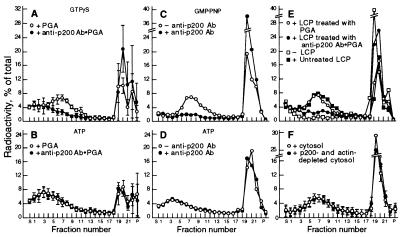Figure 2.
Effects of the anti-P200 antibody on the formation of TGN-derived vesicles. (A and B) After incubation for vesicle generation, with either GTPγS (A) or ATP (B), reaction mixtures (100 μl) were incubated for vesicle immunocapture with agarose beads containing (•—•) or lacking (○—○) bound anti-P200 antibody. The mixtures were then analyzed directly by velocity gradient centrifugation (4). For each gradient fraction, the mean and SD of four experiments are plotted. Note that in A, but not in B, the antibody-coated beads completely eliminated the vesicle peak. (C and D) LCP aliquots (1 mg protein in 25 μl), were preincubated for 30 min at 37°C with either the AD7 mAb (15 μg in 5 μl PBS), (•—•) or with PBS alone (○—○) before use in standard reaction mixtures containing either GMP-PNP to produce coated vesicles (C), or ATP to produce naked ones (D). (E) LCP aliquots (1 mg protein in 50 μl) adjusted to 0.1 M KCl, were incubated for 60 min at 37°C with either naked PGA beads (○—○), or with beads containing bound anti-P200 antibodies (•—•) to deplete immunoreactive proteins. The beads were removed by centrifugation (2 × 10 min at 10,000 × g) and the supernatants were used for vesicle generation with GMP-PNP. (F) Vesicle generation was carried out in the presence of GMP-PNP with a cytosol depleted of P200/myosin II by copolymerization with actin.

